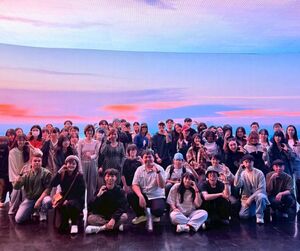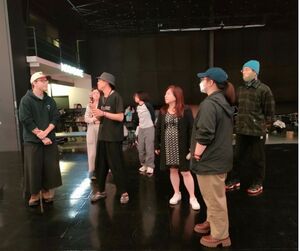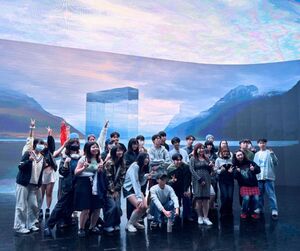Crossing Worlds with LED Screens! GCIT Students Visit MoonShine Animation to Experience the New Wave of XR Virtual Production





【Article by GCIT】
The Master’s Program in Global Communication and Innovation Technology (GCIT) at National Chengchi University (NCCU) is dedicated to cultivating media professionals with global perspectives and cross-disciplinary innovation skills. To bridge theory and practice, the program offers the course “Audiovisual Media Innovation & Interactive Technologies,” which incorporates corporate visits and Industry cooperation to help students grasp the latest communication technology trends and apply what they learn to real-world projects and future career development.
On November 11, Distinguished Professor Trisha Lin, Director of GCIT led students to visit MoonShine’s XR Virtual Production Studio in Xizhi. The visit offered an in-depth look at how artificial intelligence is revolutionizing virtual production, allowing students to experience firsthand how this technology transcends the traditional constraints of time and space in filmmaking, and to reflect on the broader implications of emerging technologies for the future of the media industry.
From VFX to AI: The Creative Power Behind World-Class Productions
Moonshine is one of Taiwan’s leading visual effects studios, with acclaimed works such as the PTS drama Gold Leaf (茶金), the concert film Mayday Life, and the Volkswagen Taiwan commercial featuring Hollywood actor Christopher Lloyd. The company’s expertise spans visual effects and post-production, 3D augmented effects, motion design, advertising, event planning, and immersive experience design (such as Moondream Reality, Kaohsiung).
In response to the rise of AI, Moonshine recently established Moonland AI, a dedicated division for AI innovation and development. The team continues to explore new forms of content creation and streamline production workflows to enhance both creativity and efficiency.
From Green Screen to Virtual Production: A New Era of Filmmaking in the Age of AI
The highlight of the visit was Moonshine’s state-of-the-art LED Virtual Production Studio. Project Manager Busta Chen explained how the studio uses high-resolution LED walls as dynamic backdrops. These panels can adjust lighting and brightness in real time, naturally reflecting light onto the set and replacing traditional green screens. This innovation shortens post-production time and eliminates the need for extensive physical set construction.
For instance, in the recently released disaster thriller 96 Minutes, Moonshine’s LED setup simulated the interior and exterior of a train car, significantly reducing production costs while improving safety and flexibility. Likewise, in the Golden Bell Award–winning miniseries Black Tide Island, the team used layered 3D enhancements to craft lifelike insect animations—demonstrating how virtual production can bring realism and creativity to a wide range of genres.
Chen noted that transitioning from green screen to AI-assisted virtual production allows directors to preview scenes in real time, make instant adjustments, and reduce production risks. This efficiency has made Moonshine a trusted partner for major international streaming platforms such as Netflix.
Student Inspiration and Future Outlook
The visit gave students a deeper understanding that the future of media production lies not merely in technical mastery but in the integration of creativity and technology. Learning to effectively combine virtual production and AI tools will be essential for enhancing both the quality and efficiency of media content creation. Throughout the visit, GCIT students actively engaged with industry professionals, asking insightful questions about the technical details of virtual production and the role of AI in creative workflows. Their curiosity and enthusiasm reflected a strong commitment to professional learning and critical thinking. At the conclusion of the visit, Prof. Lin encouraged students to work in teams to create short-form videos using the GCIT program’s own virtual production studio and AI tools—transforming classroom learning into creative innovation and preparing them for the challenges of the evolving media landscape.
For more exciting content, please visit: https://www.youtube.com/watch?v=neBK-GPiOk0&list=PLA_orAsWMVso9oZ1E3LD6SVc_K1xHcv6L
[全球傳播與創新科技碩士學位學程獲文化部與教育部高等教育深耕計畫補助。]
